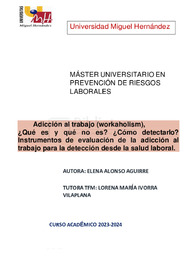Please use this identifier to cite or link to this item:
https://hdl.handle.net/11000/36574Adicción al trabajo (workaholism). ¿Qué es y qué no es? ¿Cómo detectarlo? Instrumentos de evaluación de la adicción al trabajo para la detección desde la salud laborla
| Title: Adicción al trabajo (workaholism). ¿Qué es y qué no es? ¿Cómo detectarlo? Instrumentos de evaluación de la adicción al trabajo para la detección desde la salud laborla |
| Authors: Alonso Aguirre, Elena |
| Tutor: Ivorra Vilaplana, Lorena |
| Editor: Universidad Miguel Hernández |
| Department: Departamentos de la UMH::Salud Pública, Historia de la Ciencia y Ginecología Departamentos de la UMH::Patología y Cirugía |
| Issue Date: 2024-07-21 |
| URI: https://hdl.handle.net/11000/36574 |
| Abstract: El “workaholism” se ha convertido en un tema cada vez más estudiado en nuestra sociedad, debido a sus implicaciones en la salud mental y la calidad de vida de los trabajadores. OBJETIVOS: Identificar las herramientas o instrumentos validados (cuestionarios y escalas) para detectar la adicción al trabajo desde la salud laboral, describir los rasgos de personalidad más característicos de las personas que sufren adicción al trabajo, determinar cuál es el sexo y edad más prevalentes en la adicción al trabajo, identificar cuáles son las profesiones y colectivos que, según bibliografía sufren más workaholism y analizar los niveles de adicción al trabajo detectados en los estudios experimentales y observacionales llevados a cabo en distintas profesiones entre 2019 y 2024 así como describir cuáles fueron los tipos de muestreo y estudio utilizados. MATERIAL Y MÉTODOS: Se ha realizado una revisión bibliográfica consultando las bases de datos Web Of Science, PubMed, LILACS, Scielo, PsycINFO, Cuiden, Cochrane Library, Family Health Database, IBECS, MEDES, VIDA y Google Académico; en todos los idiomas, con restricciones de fecha 2019-2024. RESULTADOS: Se encontraron un total de 28 estudios trasversales en los que se identificaron características como año de publicación, el tamaño muestral, el origen de la población de estudio, porcentaje de mujeres y hombres, escala o cuestionario validado empleado, variables medidas y asociaciones encontradas con la adicción al trabajo. CONCLUSIONES: Las escalas utilizadas con mayor frecuencia para evaluar la adcción al trabajo en los estudios incluidos en esta revisión son: la escala The Dutch Work Addiction Scale (DUWAS), seguida de Bergen Work Addiction Scale (BWAS) y la escala WorkBAT. El rasgo de personalidad más asociado a la adicción al trabajo es el neuroticismo. No hay una profesión en concreto en la que se determine mayor morbilidad de Workaholism, pero es más prevalente en profesiones sociables y que requieren cierto grado de responsabilidad. Las enfermeras presentaron un nivel moderado de adicción al trabajo, con un valor medio más alto para el trabajo en exceso. No hay predilección, según los estudios, en la prevalencia en el sexo. La edad en la que es más posible padecer esta patología comprende entre los 18 y 45 años. Las nuevas tecnologías juegan un papel importante en la adicción al trabajo. INTRODUCTION: “Workaholism” has become an increasingly studied topic in our society, due to its implications on the mental health and quality of life of workers. OBJECTIVES: Identify the validated tools or instruments (questionnaires and scales) to detect work addiction from occupational health, describe the most characteristic personality traits of people who suffer from work addiction, determine the most prevalent sex and age in workaholism, identify which professions and groups that, according to the literature, suffer the most workaholism and analyze the levels of workaholism detected in experimental and observational studies carried out in different professions between 2019 and 2024, as well as describe what the types of sampling and study used. MATERIAL AND METHODS: A bibliographic review was carried out by consulting the databases Web Of Science, PubMed, LILACS, Scielo, PsycINFO, Cuiden, Cochrane Library, Family Health Database, IBECS, MEDES, VIDA and Google Scholar; in all languages, with date restrictions 2019-2024. RESULTS: A total of 28 cross-sectional studies were found in which characteristics such as year of publication, sample size, origin of the study population, percentage of women and men, validated scale or questionnaire used, variables measured and associations found were identified. with work addiction. CONCLUSIONS: The scales most frequently used to assess work addiction in the studies included in this review are: The Dutch Work Addiction Scale (DUWAS), followed by the Bergen Work Addiction Scale (BWAS) and the WorkBAT scale. The personality trait most associated with workaholism is neuroticism. There is no specific profession in which greater morbidity from Workaholism is determined, but it is more prevalent in sociable professions that require a certain degree of responsibility. Nurses presented a moderate level of workaholism, with a higher mean value for overworking. There is no predilection, according to studies, in prevalence in sex. The age at which it is most possible to suffer from this pathology is between 18 and 45 years. New technologies play an important role in work addiction. |
| Keywords/Subjects: adicción trabajo cuestionarios rasgos personalidad workahoslim |
| Type of document: info:eu-repo/semantics/masterThesis |
| Access rights: info:eu-repo/semantics/openAccess |
| Appears in Collections: TFM-M.U en Prevención de Riesgos Laborales |
.png)

